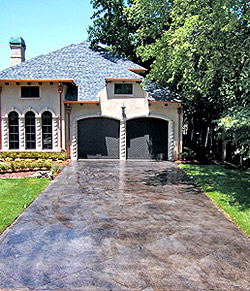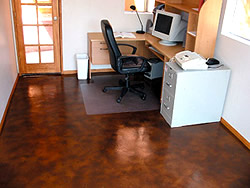 |
 |
 |
| Top: This driveway was colored with Smith’s Color Floor stains. Center: Smith Paints were used to create these realistic-looking concrete logs in St. Augustine, Florida. Bottom: Office floor using Smith Paints |
...continued from previous page
Smith Paint Products,
Harrisburg, Pennsylvania
by Jeff Woodard
The company’s introductory products for concrete — Smith’s Color Floor and Color Wall Stains — are water-based, extra-strength stains developed to achieve a natural appearance and to be a non-hazardous alternative to solvent and acid-based stains. Driven by customer requests, the Smith’s Color Floor and Color Wall lines have expanded into the Bright Lights Series (high chroma colors), Old World Series (transparent or a hint of color), effect colors and metallics.
“It seems everyone is interested in getting their sidewalk different than the guy next door,” says Brunner Sr. “Usually, it’s the front walkways or porches where they want the uniqueness. We’ve had people do patterns of stained-glass window on floors. It’s unique and, I think, just amazing.”
He notes the trend toward brighter effect colors (metallic, pearls) and an interest in bright, high-chroma colors (yellows, reds). “If you did 100 square feet, maybe only 1 or 2 square feet will have the effect color. But that little extra accent seems to set things off.”
In addition, the ability to apply more than one color at a time is leading people to experiment, he says. “At first, people would get one color and you’d get a multiple tone effect, with light and dark spots,” says Brunner Sr. “People are now putting contrasting colors over the base coat to give it more character and more pizzazz.
The Brunners have proved to be as diverse as they are innovative. Smith Paints also produces paint for spin art, paint for fingernails and paint that is specifically manufactured for the aerial billboard, sky banner and hot air balloon industries. Some are made for use by big commercial companies, while others are for “mom and pop” businesses.
Brunner Sr. is not concerned about the perceived disadvantages of being a small manufacturer. “We are probably one of the smaller manufacturers in the country,” he says. “We tend to be more flexible and responsive to a specific need, whereas a large company will want to analyze units. With our company, the guy who is going to make the decision is the guy who will know about that market. There’s less red tape with a smaller company.”
Chuck Brunner Jr. agrees. “A small company makes a little better product,” he notes. “They look at their suppliers carefully. They don’t want problems; they want quality. So a penny won’t be the difference in making a decision about raw materials.
“Quality decides it.”

|

